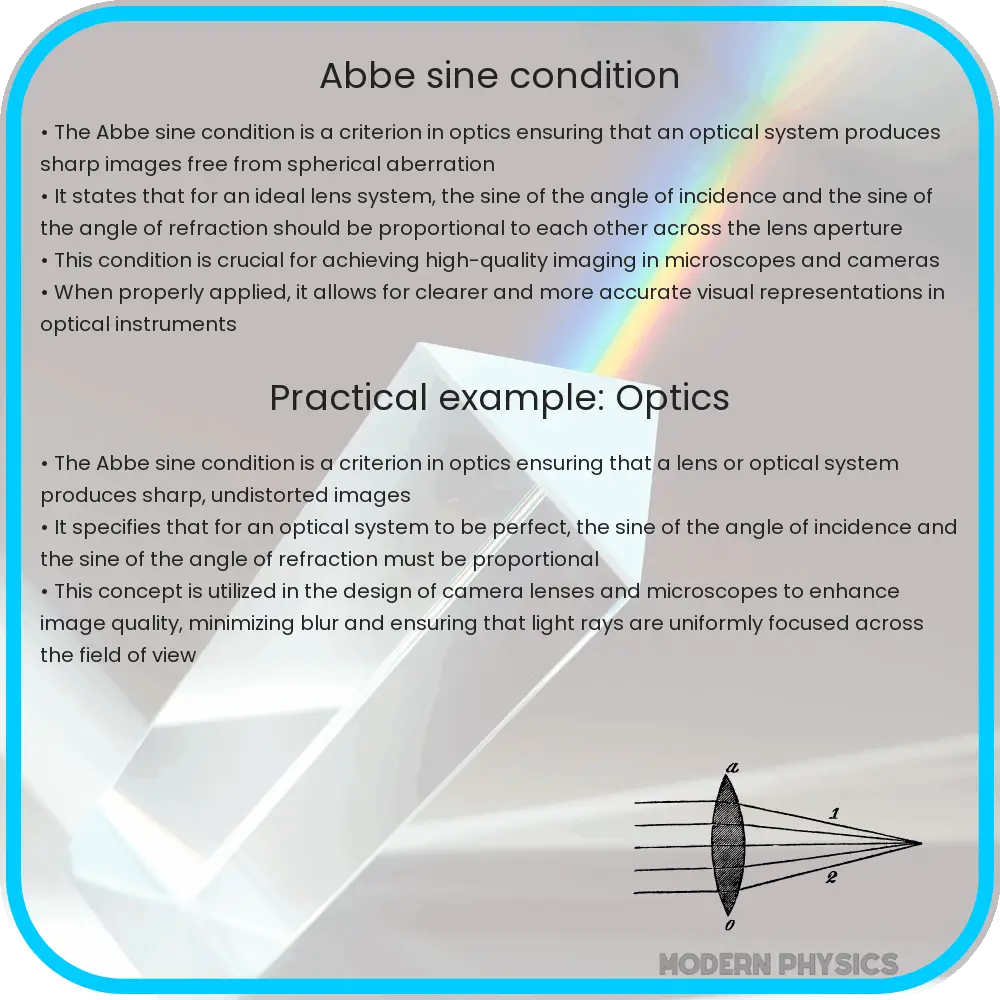Learn about the Abbe Sine Condition, a crucial principle in lens design ensuring sharp, undistorted images by minimizing coma aberrations.

Understanding the Abbe Sine Condition in Lens Design
In the realm of optical design, achieving high-quality images requires more than just focusing light; it requires controlling various aberrations that can mar an image’s clarity and precision. One of the lesser-known but fundamentally important principles in lens design is the Abbe Sine Condition. This criterion is crucial for ensuring that lenses produce sharp, undistorted images across their entire field of view, particularly in systems requiring high resolution and wide fields, such as in microscopes and telescopes.
What is the Abbe Sine Condition?
The Abbe Sine Condition, named after the German physicist Ernst Abbe, is a criterion used to ensure that an optical system is free from what is known as “coma,” an aberration that results in off-axis point sources appearing distorted, typically resembling comet-like tails. Coma is especially problematic in systems intended to image fine details across a broad field of view, as it can significantly affect the sharpness and clarity of the image.
Mathematically, the condition is expressed in terms of the angles of light rays as they enter and leave the lens system. To satisfy the Abbe Sine Condition, the ratio of the sine of the angle of incidence (the angle at which light enters the lens) to the sine of the angle of refraction (the angle at which light exits the lens) must be constant across all rays that pass through the lens. Symbolically, this can be written as:
sin(θ1)/sin(θ2) = constant
Where θ1 is the angle of incidence and θ2 is the angle of refraction. This relationship ensures that all rays of light, regardless of their angle of entry, are focused to the same point after passing through the lens, thereby eliminating coma and maintaining image sharpness and clarity.
Importance in Optical Systems
The application of the Abbe Sine Condition is particularly critical in systems where high precision is necessary. For instance, in microscopy, lenses need to be capable of producing clear and precise images of minute structures at various depths within a specimen. For telescopes, especially those used for astrophotography, lenses must provide clear images of celestial objects across a wide field of view.
Designing a lens that adheres to the Abbe Sine Condition can be challenging, particularly when working with wide-field and high-resolution applications. It often entails choosing the right materials, lens shapes, and precise positioning of various optical elements within the system. Nonetheless, achieving this condition is foundational for any high-performance optical system striving for minimal optical aberrations.
Implementing the Abbe Sine Condition in Modern Optics
In practice, implementing the Abbe Sine Condition involves a meticulous design process, where the geometries and materials of lenses are optimized to ensure that the sine condition is met. Optical engineers use sophisticated software for modeling and simulation to create complex lens systems that adhere to this principle. These simulations help in visualizing the aberrations and refining lens parameters to minimize them effectively.
Moreover, the importance of the Abbe Sine Condition extends into the manufacturing process. Precision in manufacturing is imperative because even slight deviations from the designed specifications can lead to significant aberrations, degrading the quality of the images produced. Therefore, high-tech manufacturing techniques, such as computer-controlled machining and laser-based fabrication, play critical roles in achieving the high levels of precision required.
Case Studies and Real-World Applications
To illustrate the practical applications of the Abbe Sine Condition, consider the design of objectives for modern digital cameras. Engineers often deal with the challenge of balancing high-resolution capture with wide-angle capabilities. By applying the Abbe Sine Condition during the lens design phase, manufacturers can ensure that the cameras produce vivid, clear, and undistorted images, even at the edges of the photography field.
Another example is in the design of eyeglasses and contact lenses. Here, the Condition helps in designing lenses that correct vision while providing a wide field of view, without the image distortions that would typically occur from coma and other aberrations.
Conclusion
Understanding and applying the Abbe Sine Condition is essential for developing optical systems that require high precision and clarity over a wide field of view. This fundamental principle guides engineers and designers in nearly all aspects of lens design, from the initial conceptual stages to the manufacturing process. By ensuring that optical systems satisfy the Abbe Sine Condition, manufacturers can deliver products capable of producing top-quality images, essential for applications ranging from advanced astrophotography to everyday eyewear. Thus, the Abbe Sine Condition not only reflects a profound understanding of physical optics but also serves as a critical tool in enhancing the way we visualize the world.
